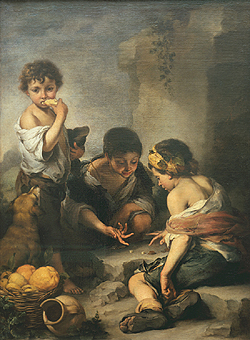On Mothering Sunday, this week’s picture is a work specifically created to evoke compassion for the child who has no mother. Three Boys Playing Dice was painted by the extravagantly gifted and equally pious Spanish artist Bartolome Esteban Murillo between approximately 1675 and 1680, not long before the end of his life. It is widely regarded as the archetypal example of a genre that Murillo made his own, the so-called “beggar-boy picture”.
In painting such works, the artist drew on his own frequent encounters with the many ragged urchins who roamed the streets of his native Seville. The number of destitute and homeless children at large in the city had multiplied alarmingly during the course of Murillo’s lifetime, due to a succession of natural disasters. Plague struck in 1649, halving the population of the city, and again in 1678, its devastating effects being compounded by crop failures, widespread famine, an epidemic of typhus and a great earthquake. Devout and well-to-do citizens like Murillo, who made his name and fortune principally as a painter of altarpieces and other large-scale religious works, formed themselves into organisations devoted to alleviating the general state of social crisis. In 1662 the painter became a member of the Franciscan Third Order, and in 1665 he joined the Seville Brotherhood of Charity. One of the tasks he undertook on behalf of the brotherhood was the distribution of bread. The sight of a destitute child stuffing food into his mouth, so vividly depicted in the picture shown here, must have been very familiar to him. The Christian connotations of the bread being so hungrily devoured would not have been lost on the painter’s devout Sevillian audience. As the scholar Peter Cherry remarks in a fascinating essay, “Murillo’s Genre Scenes and Their Context”: “bread was food and sacrament, providing...

ITP 49: Three Boys Playing Dice, by Bartolome Esteban Murillo
25-03-2001

